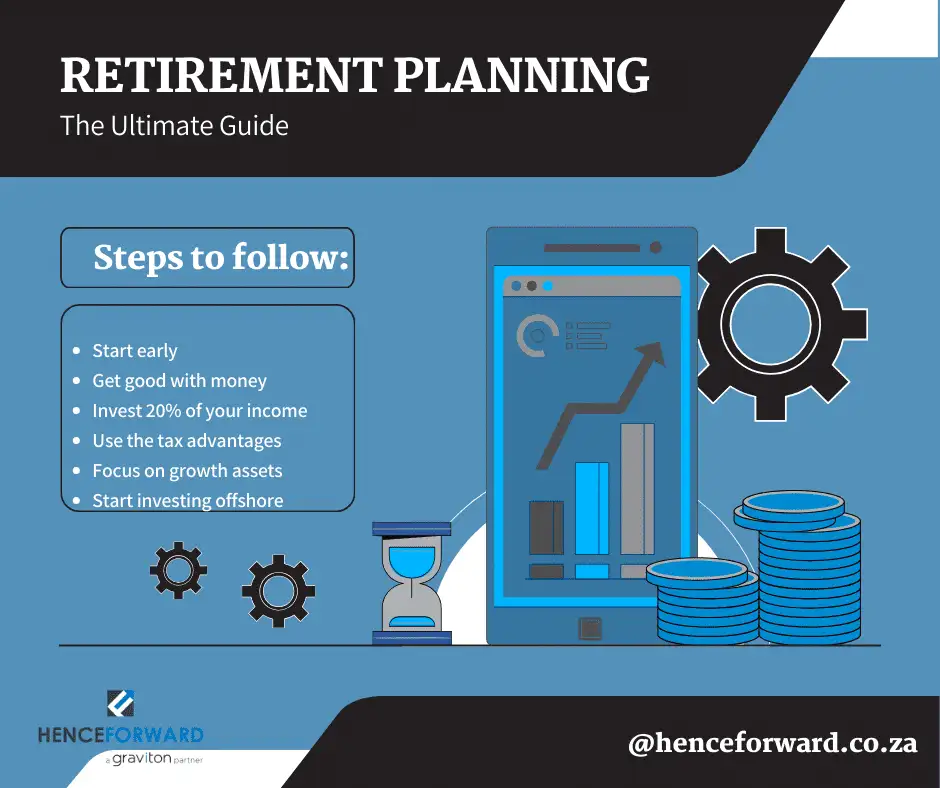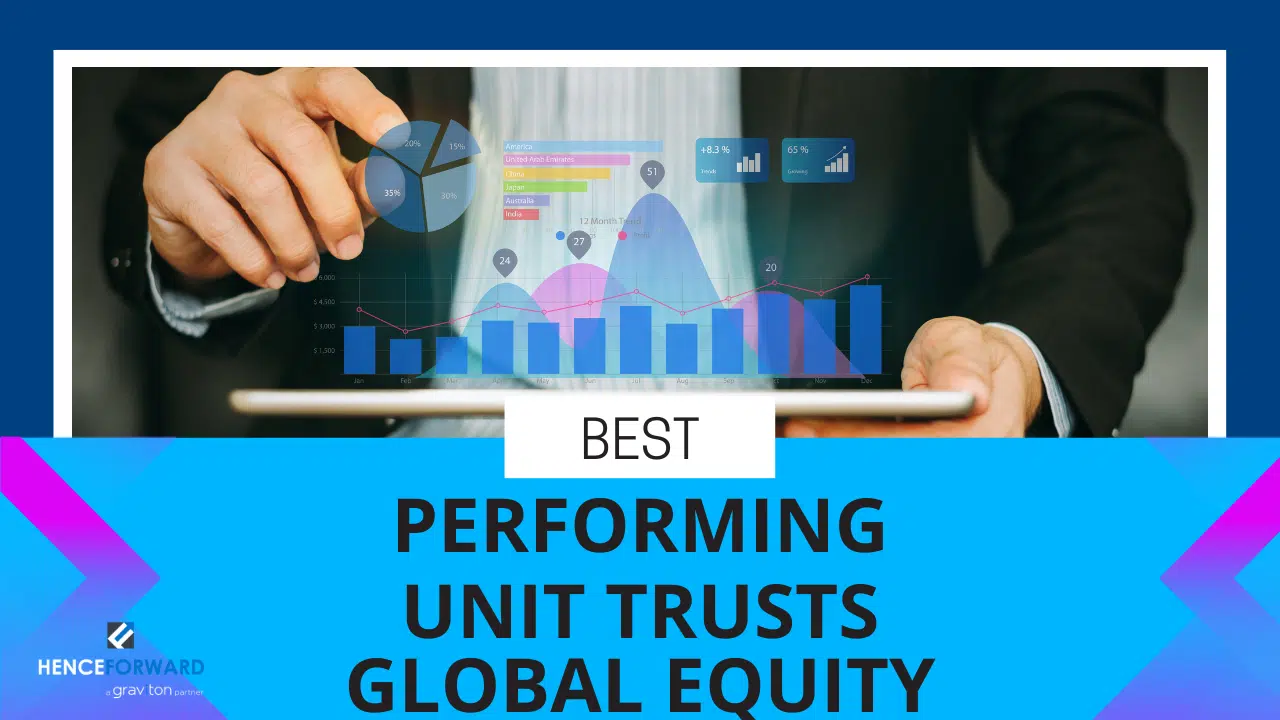Embark on your journey to financial independence with this Ultimate Retirement Planning Guide. Whether approaching retirement or just starting your career, understanding your retirement objectives is crucial. This guide offers a roadmap to enhance your retirement savings and navigate diverse investment options, including offshore ventures. Dive into this resource for strategies and insights to secure a comfortable retirement. Prefer a visual summary? Watch our highlight video below.

Table of Contents
Understanding Retirement Age in South Africa
In South Africa, the official retirement age is 55, marking the point when individuals can access their retirement savings. However, the reality for many is the necessity to work beyond 55, often into their 60s, due to insufficient funds. On the flip side, if you’ve amassed significant wealth, early retirement is certainly within reach.
Rethinking Traditional Retirement Planning
The concept of retirement planning is evolving. The traditional model – work for 40 years to enjoy retirement savings over the next 30 – is becoming less relevant. The shift from employer-guaranteed pensions (defined benefit) to defined contribution pensions, where individuals bear the investment risks and uncertainties, challenges this old model. As life expectancy increases, ensuring financial security in retirement becomes more complex.
The Reality of Retirement in South Africa
- Statistics reveal that only about 6% of South Africans achieve a ‘comfortable’ retirement, defined by a replacement ratio of 75% of your final income.
- So for example if your income is R50,000 p.m. at retirement, if you have enough capital invested that can provide you with a starting income of R37,500 p.m. (and increase annually with inflation) – you’ve achieved ‘success.’
- While this calculation has limitations, this stark figure underscores the importance of understanding the current retirement landscape to make informed decisions for financial independence. The path to a secure retirement is challenging, yet understanding these realities is the first step towards taking control of your financial future.
Defining a Successful Retirement
A successful retirement is subjective, varying greatly from one individual to another, primarily based on the desired lifestyle and the financial means to support it. However, the retirement industry generally suggests a financial benchmark for a comfortable retirement via the following formula:
- To secure a retirement with a 75% Replacement Ratio (RR), it’s recommended to invest 17% of your income for 40 years.
While this statistic serves as a guideline, personal needs and circumstances can differ significantly. Committing to invest nearly a fifth of your gross income over a 40-year career requires early planning, dedication, and consistent effort. Setting clear financial goals and starting early are so important.
Source: The Alexander Forbes Member Insights 2021 analyzing data from around a million retirement fund members across nearly 2000 schemes, offers valuable insights. This extensive data helps dissect crucial information, aiding individuals in aligning their strategies to achieve their unique retirement goals.
Summary of Key Retirement Savings Statistics
Thanks to Alexander Forbes insights linked above, (as South Africa’s leading administrator of employer-sponsored retirement funds), we have access to vital statistics that paint a clear picture of our retirement landscape.
Contribution Rates:
- The average retirement savings contribution (including employer contributions) is only 12.9%, below the recommended 17%. This indicates a general shortfall in savings, though there’s a positive trend in contributions from 2012 to 2020.
Average Replacement Ratios:
- The average replacement ratio (RR) for retirement savings is slightly over 40%, significantly below the ideal 75% RR. For retirees in 2020, the average RR was even lower at 31%. The major hurdles are insufficient savings and failure to preserve benefits when changing jobs. For a 75% RR, a fund credit of around 11 times the final salary is necessary.
Retirement Savings by Age Group:
- Younger individuals (below 25) show a higher probability (nearly 30%) of achieving a 75% RR, highlighting the advantage of starting early. The likelihood diminishes with age, with a sharp decline in potential RR after the age of 25.
Impact of Starting Age on RR:
- Beginning retirement savings at age 20 with a 17% contribution can lead to an approximate 90% RR. Even a slightly lower contribution of 15% results in an 80% RR. However, delaying the start to age 25 or later significantly decreases the potential RR. A start at age 30 with a 17% contribution leads to only about a 60% RR, emphasizing the critical role of time in retirement planning.
These statistics underscore the importance of early and adequate contributions to retirement savings, as well as the benefits of preserving those savings throughout one’s career.
Reframing Retirement Planning: Beyond the Numbers
The statistics don’t capture the full scope of retirement readiness. Investments beyond traditional retirement funds, like property, discretionary investments, and offshore assets, contribute significantly to a comfortable retirement. Diversification is key. Moreover, the retirement landscape in the 2050s and 2060s will likely shift dramatically. Technological and scientific advancements may extend lifespans, while AI and robotics transform the work environment. The gig economy might dominate, demanding new, adaptable skill sets and redefining the concept of work beyond the traditional 9-to-5 job. This evolving landscape underscores the importance of starting retirement planning early while staying flexible to navigate the future’s uncertainties. Financial planning isn’t just about preparing for retirement; it’s about adapting to a continuously changing world.

Retire Smart Principles
Principle 1: Financial Discipline Today for a Better Tomorrow
The cornerstone of retiring smart is managing your finances prudently today. It’s about living within your means and making intelligent spending choices—investing in meaningful experiences rather than fleeting material goods.
Interesting Fact: On average, men allocate over half of their income to debts like mortgages and car loans, while women typically use 20-40% of their income for such expenses. Imagine the possibilities if, instead, those funds were invested.
Consider the impact of purchasing a more affordable home or opting for a less extravagant car. These choices can free up resources for investment, rather than servicing debt. The goal is simple: prioritize financial freedom over temporary luxuries.
Principle 2: Harness the Power of Compounding
Compounding interest is the most potent tool in your financial arsenal. The difference it makes over time is astounding. For example, a monthly investment of R5,000 grows to R7.5 million over 30 years and balloons to R17.5 million over 40 years, assuming an 8% annual return. Out of that R17.5 million, only R2.4 million are your contributions.
This principle isn’t about the figures per se but the value of time. Begin early, remain consistent, and increase your contributions when possible. Instead of succumbing to lifestyle inflation, practice ‘investment creep’—using salary hikes to boost your retirement fund.

Principle 3: Invest in Yourself
Your greatest asset is you. Enhancing your skills, knowledge, and competencies is the most effective way to increase your financial capabilities. Whether you’ve received top-tier education or not, there’s always room to maximize your potential. Seek out ways to upskill—formal education isn’t the only path to success. Numerous individuals have achieved great success without it, through self-education and practical experience.
Streamlining Your Retirement Investments
Overview of Retirement Investment Options
- The journey to financial independence includes diversifying your investments across various assets, products, and strategies. The government offers incentives for retirement planning through tax advantages, encouraging you to be less dependent on state resources in your golden years.
Understanding Approved Retirement Funds in South Africa
- Approved retirement funds, such as pension, provident, preservation, or retirement annuity funds, offer tax deductions up to 27.5% of your income, with a maximum of R350,000 per year for all contributions. From age 55, you can access a third of your fund as a tax-free lump sum and use the remainder to purchase an annuity for retirement income.
Employer-Sponsored Funds and Individual Contributions
- With pension and provident funds typically employer-sponsored, and retirement annuities geared towards individual savers, there are choices for everyone. All funds allow tax-free growth until retirement, when the income becomes taxable.
Maximizing Benefits
- Leverage tax breaks and employer matching contributions—essentially ‘free money’—to your advantage. When changing jobs, resist cashing out; instead, preserve your nest egg through a preservation fund. Stay informed about the upcoming two-pot retirement system.
Actionable Advice
If you’re part of an employer-sponsored fund, delve into the details. How can you enhance your contributions? What investment options suit you best, especially if retirement is more than 7 years away? (Hint: opt for high equity allocation). Don’t overlook additional perks like medical benefits or share options. And if it’s overwhelming, consider enlisting a financial planner to navigate the complexities.
Retirement annuities are of course popular vehicles used to make individual retirement contributions. Used well, they also have many benefits. Unlike with pension and provident funds, they don’t give you access until you reach the age of 55 (if you move jobs) – which is a good thing – and will be changing with the new two pot system anyway. Read our article on the benefits of using a retirement annuity as part of your retirement planning strategy.
Rethinking Retirement Investment Strategy: The Debate on Regulation 28
Regulation 28 has its pros and cons, and its impact on long-term investment outcomes is often debated. The regulation places a ceiling on potential returns by limiting equity exposure, which could be a hindrance for young investors seeking growth through equities. Additionally, it restricts offshore investment exposure, leaving South African investors with a smaller piece of the global investment pie, despite an increase to the offshore allocation limit of 45%.
Underwhelming Returns:
- Looking at the performance of South Africa’s Multi-Asset High-Equity funds, traditionally favored by retirement savers, the returns have been underwhelming, averaging 7.23% per annum over the last 10 years. (source: Morningstar and retail fund classes). This falls short of the common Inflation Plus 5 benchmark (i.e. more like 10% p.a.) needed to achieve a successful retirement and poses a challenge to those striving for a comfortable retirement.
We hope that with the relaxed rules of Regulation 28 allowing for more offshore exposure, and potentially better performance from our domestic markets, the future may offer improved returns. However, innovative thinking and exploring additional investment avenues remain crucial.
Leveraging Tax Free Savings Accounts (TFSAs)
- TFSAs are a flexible, tax-efficient tool to complement your retirement portfolio. With a R36,000 annual cap and a R500,000 lifetime contribution limit, their growth and withdrawals are tax-free. These accounts operate without the investment constraints of retirement funds, offering another strategy for accumulating wealth.
For instance, starting at age 30 and contributing the maximum R36,000 per year, you could accumulate approximately R1 million in 14 years with a 10% annual return. Left to grow for another 20 years, this could result in over R7 million tax-free, which could fund your lifestyle before you tap into other retirement savings.
The Case for Offshore Investing
Global wealth is typically measured in USD, prompting the consideration of financial security in hard currency terms. Given the long-term devaluation trend of the Rand against the dollar, offshore investing can serve as a hedge, capitalizing on this depreciation while also offering a broader range of investment opportunities.
If you foresee emigration or international living in your future, having investments in a stronger currency can provide significant advantages. Additionally, with the cost-effectiveness for ‘swallows’ living part-time in South Africa due to favorable exchange rates, the benefits of holding hard currency are clear. Offshore investments can also fund international travel without reliance on the weakening Rand.
With most personal wealth tied to the Rand and local economy through property, retirement funds, and other investments, diversification offshore can balance your financial portfolio, providing stability against domestic volatility.
Read Next: The 10 Biggest Retirement Planning Mistakes to Avoid

Retirement investing compared to offshore investing
Challenges in Modeling Long-Term Returns
- Attempting to model the long-term returns of South African retirement funds versus offshore funds is a complex task. The landscape has undergone significant changes over the past three decades, both globally and within the South African retirement fund industry.
The South African Market: A Retrospective
- The ’90s and early 2000s were relatively prosperous times for South African markets, with GDP growth and a thriving resource sector, largely driven by China’s demand. However, the scenario has shifted considerably. South Africa’s economic growth has slowed, China’s demand has weakened, and consequently, the returns from our resource-driven market have diminished.
The Shift to a Digital Global Economy
- The global economy is transitioning towards digitalization, propelled by AI and automation. South Africa’s local exchanges lack significant representation in companies poised to capitalize on this digital shift.
Balancing Retirement Funds and Offshore Investments
- It’s not a question of forgoing retirement funds; their tax benefits and enforced saving disciplines are valuable. Yet, when you juxtapose the average balanced fund return of 7.23% per annum with the approximately 15% per annum yielded by a basic global stock index over the last decade, the stark difference cannot be overlooked, despite the tax incentives.
Adopting a Multi-Faceted Approach to Retirement
- Smart retirement planning requires ingenuity and a proactive stance. Diversifying your strategies and incorporating various products and investment avenues is crucial to achieving financial independence. It’s about strategic placement and broader thinking to navigate the evolving economic landscape effectively.

*When comparing the Rand returns of the S&P500 and World Stock Index above, to a typical South African Balanced Fund, the difference in what that translates to is enormous. You have almost 3X and 2.5X in actual end amounts over a 10-year period. No tax incentives will make up the difference. Now will this always be so? We hope not! But we also have to be realistic enough to accept that if you’re serious about financial freedom, it’s going to require a lot more creativity in how to go about achieving it.
Conclusion: Crafting Your Ideal Retirement Planning Portfolio
Investment returns, much like life’s many facets, move in cycles. Putting all your assets in one investment basket is a strategy fraught with risk. A robust retirement plan should weave together a variety of investment products and assets, spanning both local and international markets. Prioritizing offshore investments as a thoughtful, intentional component of your portfolio can be immensely rewarding over time.
Determining the exact allocation between different investment avenues is not a one-size-fits-all matter; it hinges on your unique financial situation and investment capacity. The cornerstone of a successful investment journey is to begin early and stay the course with unwavering commitment. As your financial resources expand, you have the liberty to diversify further, integrating an array of strategies and methods to enrich your investment mix and secure a prosperous retirement.
Read Next: A few possible shares to consider buying that can accelerate your jouney to financial freedom.
Post-Retirement Planning
Once you’ve reached retirement age (55 onwards), you move to a stage of life where deaccumulation rather than the accumulation of assets becomes your primary concern. Said differently, it means investing for income rather than growth. All the money you’ve accumulated in your retirement fund assets (and hopefully others) now needs to be invested to provide you with an income for the rest of your life. And you must also decide between two fundamentally different options. You can either purchase a guaranteed income for life via a guaranteed life annuity, or you can choose an investment linked income in the form of a living annuity.
Further Reading: The Best Balanced Funds for Retirees to Consider
Henceforward Retirement Insights 2024 Report
To help you make that decision and allow you to make an educated and informed choice about how best to invest your retirement capital, we have authored the Henceforward Retirement Insights 2024 report. It’s a detailed and comprehensive guide that prepares you for retirement and what you need to do to retire successfully. Click on the image to find out more.
Unlock your journey to a secure, informed retirement with your FREE copy of the Henceforward Retirement Insights 2023. Tailored to navigate the complexities of retirement finances, this report is your comprehensive guide through significant decisions and strategies. From managing cash and taxes to understanding annuities and navigating market risks, it empowers you with the knowledge to transition smoothly into your golden years. Dive into proven strategies, decode the impact of fees, and shape your retirement with confidence.
Download now and embrace a future of financial clarity and peace of mind.

Carl-Peter Lehmann
Carl-Peter is a Director and Partner at Henceforward. He is a Certified Financial Planner® and has more than 20 years industry experience, having also worked internationally helping people invest their money and plan for retirement.






